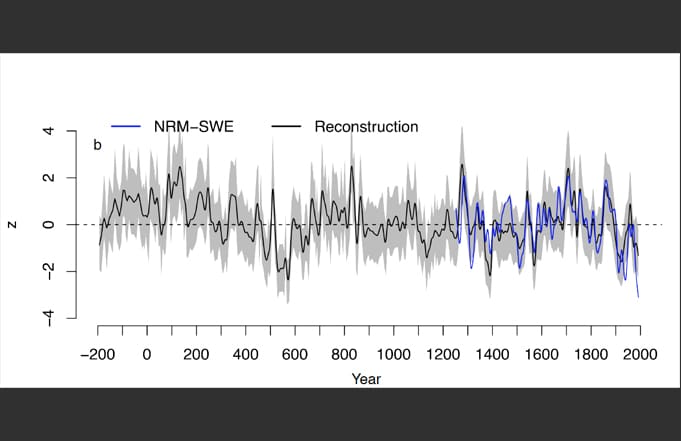September 2, 2020
Dr. Spruce W. Schoenemann from the University of Montana Western's Environmental Sciences Department recently published his work in the journal of Quaternary Science Advances for research on snowpack in the northern Rocky Mountains.

The research paper titled “2200-Year tree-ring and lake-sediment based snowpack reconstruction for the northern Rocky Mountains highlights the historic magnitude of recent snow drought” is a peer-reviewed article authored by Schoenemann with assistance from Justin T. Martin and Gregory T. Pederson of the Northern Rocky Mountain Science Center in Bozeman, and David B. McWethy from the Earth Sciences Department at Montana State University.
The publication details Schoenemann’s work to extend records of April 1 Snow Water Equivalence (the amount of water contained within the snowpack) for the northern Rocky Mountains to evaluate the magnitude of recent snow drought over the last few decades.
To further tree-ring based reconstructions, Schoenemann used carbonate isotope lake sediment records from Foy Lake, Mont. to create a 2200-year preliminary reconstruction of the northern Rockies snowpack, providing important long-term context and understanding of drivers of snowpack variability over the Common Era (C.E.).
In an interview with Schoenemann, he explained that researchers had used snowpack sensitive tree-ring species throughout the northern Rockies to research snowpack in the past. When these trees, like the Douglas Fir, for example, experience a harsh long winter and get a later start to the growing season, it can be seen by a smaller ring width. On the contrary, ring widths will typically be larger during a mild winter and more extended growing season.
The tree-ring reconstruction used in Schoenemann’s research was originally completed by Greg Pederson and published in Pederson’s 2011 Science paper. The paper reconstructed snowpack, as Snow Water Equivalent (SWE), by taking tree ring records that are annually dated, and comparing them to the modern observations from the SNOTEL sites around the northern Rockies and noting the correlation. SNOTEL sites are automated stations that measure snow water content.
As explained in the article, “long-term records of snowpack prior to the installation of snowpack observation stations in the early and mid 20th century are limited.” The earliest data on these snow observations began around the 1930s, but tree ring reconstruction can go back 800 years to around 1200 C.E.
Schoenemann then started looking at lake sediment records that should be sensitive to snowpack. The idea was to look at high alpine lakes or lakes that are in a snowpack dominated environment. When the snow melts and flows into the lake system as water or H2O, it’s possible to look at the oxygen, which has two isotopes, 16O and 18O. The water that comes from snowmelt and travels into the lake changes the lake-water’s isotopic content for that year. If it’s a winter with a lot of snow, the new water volume brings a new isotopic signal to the lake.
During the summer, the calcium carbonate (CaCO3) incorporates the same oxygen isotopes from the water. That carbonate then precipitates out into the lake as a calcium carbonate sediment. When Schoenemann then measures the lake sediments’ isotopic content, that same signal from the water gets imparted to the lake, which then gets imparted to the sediment.
The sediment records then can go back thousands of years (in this case 2,200 years), and that’s when Schoenemann can take the tree-ring chronologies and overlap them with the lake records and note the correlation.

“The reason this approach is groundbreaking and novel is that we now have 800 years where we can statistically calibrate the two records. Normally, researchers take a lake record, and they look at the last 100 years, which may only give them 10 data points of overlap. Then they try to take those 10 data points and line them up with 100 years of historical data. Statistically, you can’t get a good correlation with that limited set of data,” Schoenemann said.
This addition of 1400 years of snowpack reconstruction highlights the severity of snow drought over recent decades. The publication states that “the most recent decades of the record are as dry as any in the last 2,200 years.”
“The tree-ring records are the critical link to identify the long-term climate sensitivity of the lake system, which can be calibrated over the common period of overlap (~800 years in this case), producing a more robust assessment than current approaches. Additionally, the sediment core ages, which are typically interpolated between radiocarbon ages, can be adjusted to more closely match the absolutely dated tree-rings. The extended snowpack reconstruction is important, as it provides us with a long-term view of how northern Rocky Mountain snowpack has varied in the past, and how low the past century SWE has been in comparison to the long-term average. This has serious implications for water resources as snowpacks are projected to further decline in a warming world,” Schoenemann said.
To view Schoenemann’s entire publication, visit sciencedirect.com. For more information, please email [email protected].